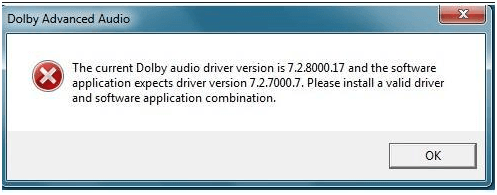

- #Dolby advanced audio v2 windows android#
- #Dolby advanced audio v2 windows iso#
- #Dolby advanced audio v2 windows plus#
The SSR uses a 4-band PQMF filterbank, with four shorter filterbanks following, in order to allow for scalable sampling rates. The Main profile adds a set of recursive predictors that are calculated on each tap of the filterbank. AAC-LC profile consists of a base format very much like AT&T's Perceptual Audio Coding (PAC) coding format, with the addition of temporal noise shaping (TNS), the Kaiser window (described below), a nonuniform quantizer, and a reworking of the bitstream format to handle up to 16 stereo channels, 16 mono channels, 16 low-frequency effect (LFE) channels and 16 commentary channels in one bitstream. MPEG-2 Part 7 defined three profiles: Low-Complexity profile (AAC-LC / LC-AAC), Main profile (AAC Main) and Scalable Sampling Rate profile (AAC-SSR). Therefore, MPEG-2 Part 7 is also known as MPEG-2 NBC (Non-Backward Compatible), because it is not compatible with the MPEG-1 audio formats ( MP1, MP2 and MP3). This part of MPEG-2 was a new part, since MPEG-2 already included MPEG-2 Part 3, formally known as ISO/IEC 13818-3: MPEG-2 BC (Backwards Compatible). In 1997, AAC was first introduced as MPEG-2 Part 7, formally known as ISO/ IEC 13818-7:1997. It is specified both as Part 7 of the MPEG-2 standard, and Subpart 4 in Part 3 of the MPEG-4 standard. It was officially declared an international standard by the Moving Picture Experts Group in April 1997. ĪAC was developed with the cooperation and contributions of companies including Bell Labs, Fraunhofer IIS, Dolby Laboratories, LG Electronics, NEC, NTT Docomo, Panasonic, Sony Corporation, ETRI, JVC Kenwood, Philips, Microsoft, and NTT. AAC uses a purely MDCT algorithm, giving it higher compression efficiency than MP3. The MP3 audio coding standard introduced in 1994 used a hybrid coding algorithm that is part MDCT and part FFT. Bradley in 1987, following earlier work by Princen and Bradley in 1986. This led to the development of the modified discrete cosine transform (MDCT), proposed by J. Rao in 1973, publishing their results in 1974. The discrete cosine transform (DCT), a type of transform coding for lossy compression, was proposed by Nasir Ahmed in 1972, and developed by Ahmed with T. It is also one of the audio formats used on the Spotify web player. AAC is also supported by manufacturers of in-dash car audio systems.
#Dolby advanced audio v2 windows android#
It is supported on PlayStation Vita, Wii, Sony Walkman MP3, Android and BlackBerry.
#Dolby advanced audio v2 windows plus#
ĪAC is the default or standard audio format for iPhone, iPod, iPad, Nintendo DSi, Nintendo 3DS, YouTube Music, Apple Music (only used on web player, Google Home, Amazon Alexa, and Microsoft Windows app.), iTunes, DivX Plus Web Player, PlayStation 4 and various Nokia Series 40 phones. AAC uses only a modified discrete cosine transform (MDCT) algorithm, giving it higher compression efficiency than MP3, which uses a hybrid coding algorithm that is part MDCT and part FFT. Tests of MPEG-4 audio have shown that AAC meets the requirements referred to as "transparent" for the ITU at 128 kbit/s for stereo, and 320 kbit/s for 5.1 audio. The quality for stereo is satisfactory to modest requirements at 96 kbit/s in joint stereo mode however, hi-fi transparency demands data rates of at least 128 kbit/s ( VBR). Part of AAC, HE-AAC ("AAC+"), is part of MPEG-4 Audio and is adopted into digital radio standards DAB+ and Digital Radio Mondiale, and mobile television standards DVB-H and ATSC-M/H.ĪAC supports inclusion of 48 full- bandwidth (up to 96 kHz) audio channels in one stream plus 16 low frequency effects ( LFE, limited to 120 Hz) channels, up to 16 "coupling" or dialog channels, and up to 16 data streams.
#Dolby advanced audio v2 windows iso#
ĪAC has been standardized by ISO and IEC as part of the MPEG-2 and MPEG-4 specifications. Designed to be the successor of the MP3 format, AAC generally achieves higher sound quality than MP3 encoders at the same bit rate. MPEG-4 Part 14, 3GP and 3G2, ISO base media file format and Audio Data Interchange Format (ADIF)Īdvanced Audio Coding ( AAC) is an audio coding standard for lossy digital audio compression.


 0 kommentar(er)
0 kommentar(er)
